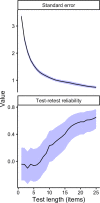An efficient and adaptive test of auditory mental imagery
- PMID: 32356009
- PMCID: PMC8049941
- DOI: 10.1007/s00426-020-01322-3
An efficient and adaptive test of auditory mental imagery
Abstract
The ability to silently hear music in the mind has been argued to be fundamental to musicality. Objective measurements of this subjective imagery experience are needed if this link between imagery ability and musicality is to be investigated. However, previous tests of musical imagery either rely on self-report, rely on melodic memory, or do not cater in range of abilities. The Pitch Imagery Arrow Task (PIAT) was designed to address these shortcomings; however, it is impractically long. In this paper, we shorten the PIAT using adaptive testing and automatic item generation. We interrogate the cognitive processes underlying the PIAT through item response modelling. The result is an efficient online test of auditory mental imagery ability (adaptive Pitch Imagery Arrow Task: aPIAT) that takes 8 min to complete, is adaptive to participant's individual ability, and so can be used to test participants with a range of musical backgrounds. Performance on the aPIAT showed positive moderate-to-strong correlations with measures of non-musical and musical working memory, self-reported musical training, and general musical sophistication. Ability on the task was best predicted by the ability to maintain and manipulate tones in mental imagery, as well as to resist perceptual biases that can lead to incorrect responses. As such, the aPIAT is the ideal tool in which to investigate the relationship between pitch imagery ability and musicality.
Conflict of interest statement
All authors declare that they have no conflict of interest.
Figures




References
-
- Alloway TP, Gathercole SE, Kirkwood H, Elliott J. Evaluating the validity of the automated working memory Assessment. Educational Psychology. 2008;28(7):725–734. doi: 10.1080/01443410802243828. - DOI
-
- Baddeley, A. D., & Andrade, J. (2000). Working memory and the vividness of imagery. Journal of experimental psychology. General, 129(1), 126–145. Retrieved from https://psycnet.apa.org/journals/xge/129/1/126/ - PubMed
MeSH terms
Grants and funding
LinkOut - more resources
Full Text Sources
Research Materials

